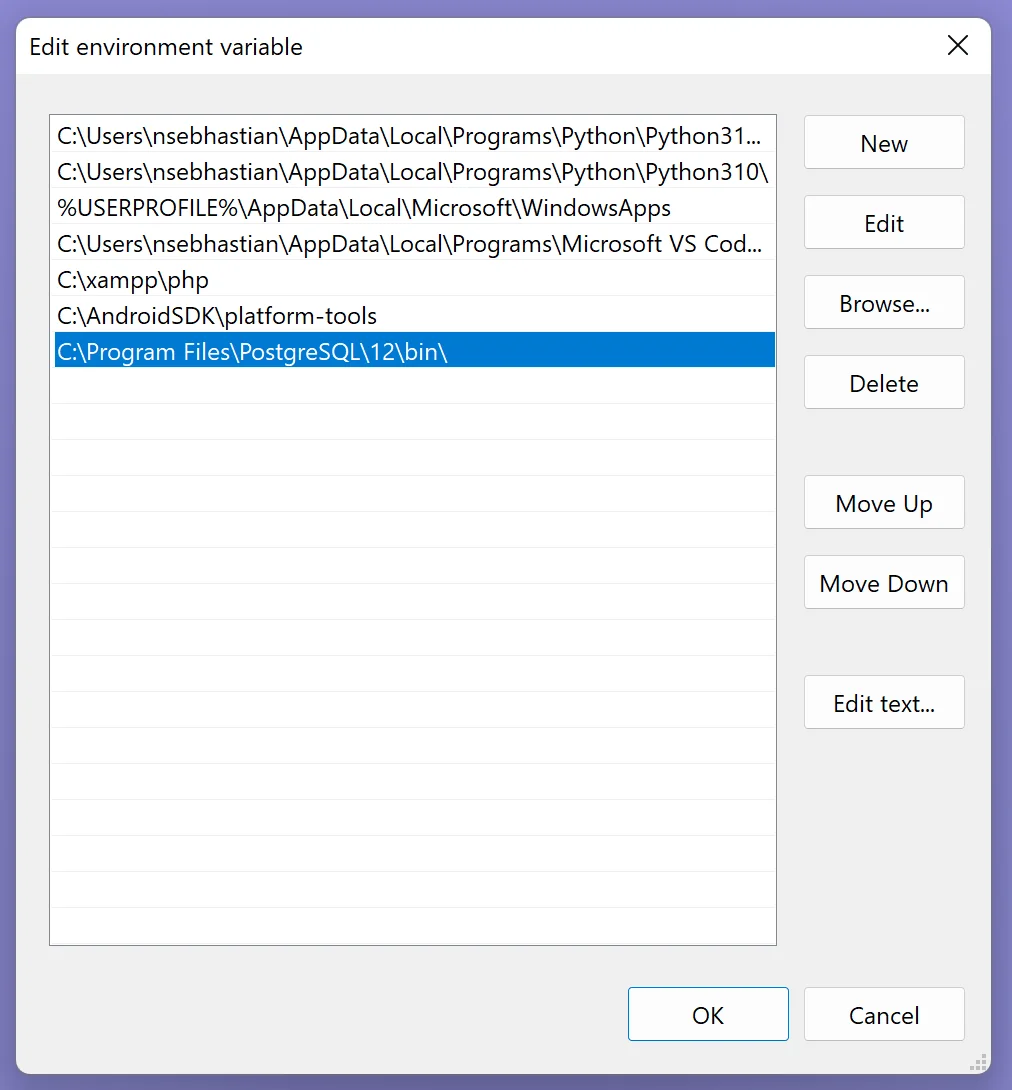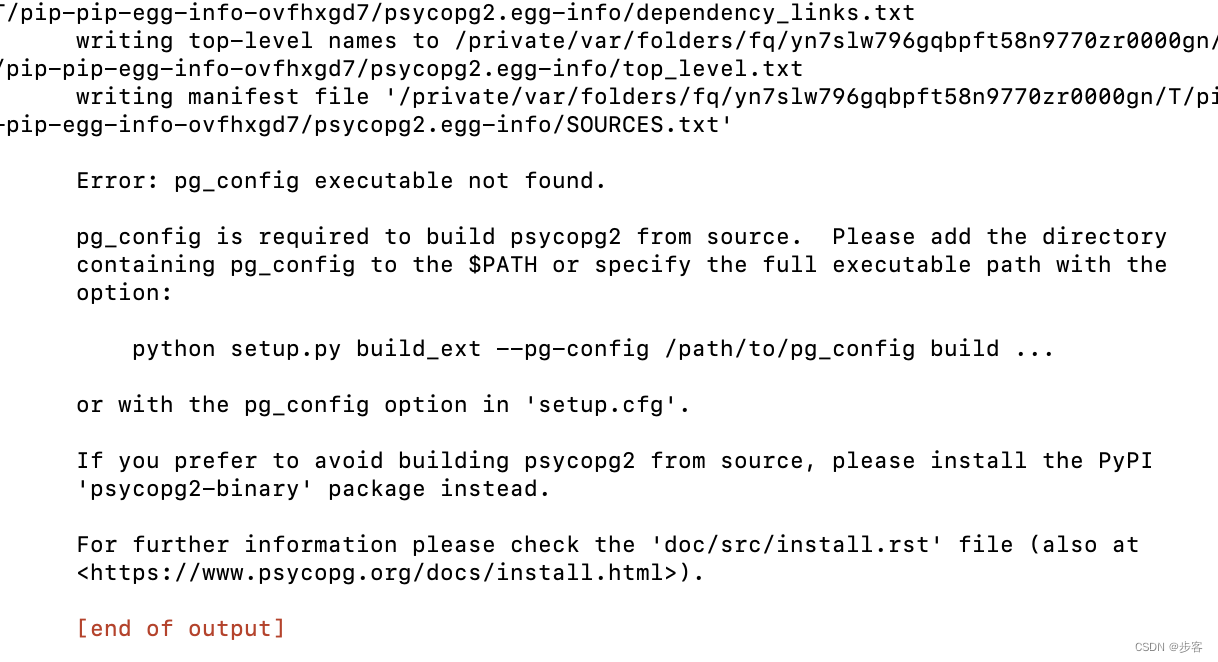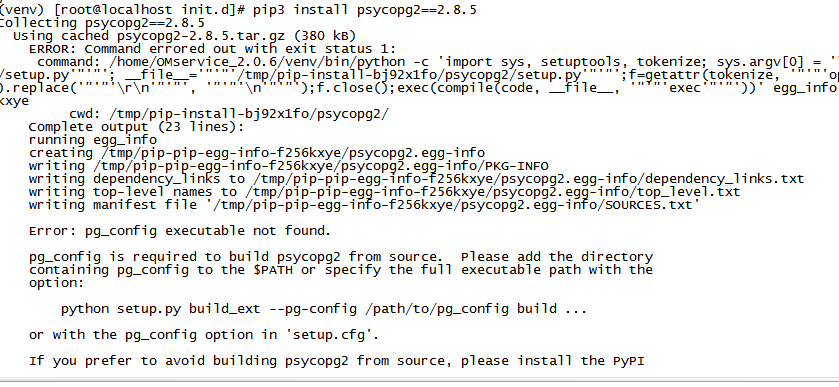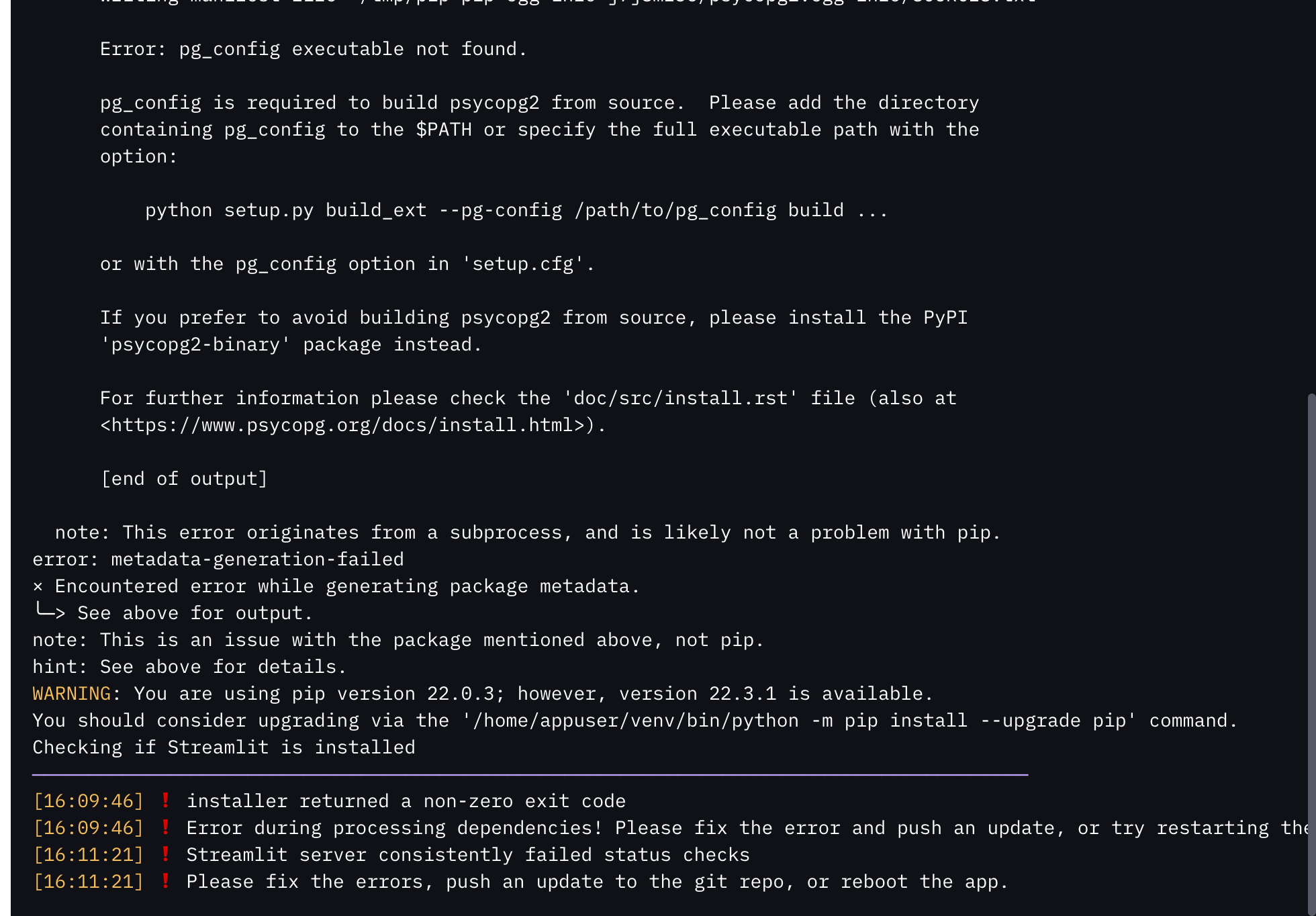Pg_Config Executable Not Found
Introduction:
The “pg_config executable not found” error is a common issue faced by developers working with PostgreSQL, especially during software installations or while configuring their development environment. This error indicates that the system is unable to locate the pg_config executable, which is a critical component for various PostgreSQL-related tasks. In this article, we will delve into the causes behind this error, explore troubleshooting steps, and provide alternative solutions to resolve it.
1. Overview of the Error: Understand the Scope
The “pg_config executable not found” error generally occurs when trying to install or configure PostgreSQL or any module that depends on it. It indicates that the system cannot locate the pg_config executable file required for proper functioning. This error can manifest across various platforms, including macOS, Docker, and Windows 10.
2. Understanding pg_config: What it is and Why it is Important
The pg_config executable is a utility provided by PostgreSQL that enables system information retrieval, such as compiler and linker flags, installation directories, and PostgreSQL library locations. It plays a vital role in dependency resolution and building extensions for PostgreSQL.
3. Causes of the “pg_config executable not found” Error
There are several common causes for this error, including:
– Missing or misplaced pg_config binary in the system.
– Incorrect system environment variables, which prevent the system from locating pg_config.
– Installation of PostgreSQL or related libraries not completed successfully.
4. Troubleshooting Steps: Checking System Environment Variables
To troubleshoot the error, verify the system’s environment variables. Ensure that the PATH variable includes the directory where the pg_config executable is located. Additionally, check if the system environment variable `PG_CONFIG` is correctly set to the path of the pg_config binary.
5. Alternative Solutions: Manually Specifying the pg_config Location
If the pg_config executable is not found automatically, you can manually specify its location during installations or configurations. By setting the environment variable `PG_CONFIG` to the appropriate path, you can inform the system of the correct location of pg_config.
6. Checking for Missing Dependencies: Reinstalling PostgreSQL
Another possible solution is to reinstall PostgreSQL and its dependencies, as the error might occur due to missing or corrupt files. Additionally, ensure that the installation is successful and complete without any errors.
7. Verifying the PostgreSQL Installation: Ensuring pg_config Availability
To ensure that PostgreSQL is installed correctly, check if the pg_config file is present in the appropriate installation directories. The location may vary depending on the platform, but it is usually found in the `bin` directory of PostgreSQL installation.
8. Common Issues and Workarounds: Dealing with Platform-Specific Problems
Different platforms may have specific issues related to the “pg_config executable not found” error. Some common scenarios include macOS, Docker, and Windows 10. This section will provide platform-specific workarounds to address these issues.
9. Seeking Support: Community Resources and Professional Assistance
If the error persists or requires in-depth investigation, it is advisable to seek support from the PostgreSQL community or professional assistance. Several online forums and mailing lists dedicated to PostgreSQL offer guidance and expertise on resolving such issues effectively.
FAQs:
Q1. How can I resolve the “pg_config executable not found” error on macOS?
A1. On macOS, ensure that you have installed the Command Line Tools for Xcode and that PostgreSQL is correctly installed. If the error persists, try reinstalling PostgreSQL and updating your environment variables.
Q2. When using Docker, how can I fix the “pg_config executable not found” error?
A2. With Docker, ensure that you have correctly configured the Dockerfile or your container’s environment to have pg_config available. Make sure the necessary PostgreSQL packages are installed inside the Docker image.
Q3. What steps can I take to resolve the “pg_config executable not found” error on Windows 10?
A3. On Windows 10, verify that PostgreSQL is properly installed and its installation directory is added to the system’s PATH variable. Additionally, ensure that the `PG_CONFIG` environment variable is set correctly.
Q4. Is pg_config necessary for installing Psycopg2 or other PostgreSQL-related Python packages?
A4. Yes, pg_config is required to build Psycopg2 and other PostgreSQL-related Python packages from source. It is necessary for the correct resolution of dependencies during installation.
Q5. How can I install psycopg2 with pip when encountering the “pg_config executable not found” error?
A5. To install psycopg2 with pip, ensure that you have PostgreSQL and the development packages installed on your system. If the error occurs, try specifying the pg_config location manually using the `PG_CONFIG` environment variable.
Q6. What is the purpose of the `libpq-dev` package in resolving the “pg_config executable not found” error?
A6. The `libpq-dev` package provides the header files necessary for compiling and linking programs with PostgreSQL libraries. Installing this package can help resolve the “pg_config executable not found” error.
Q7. How can I install psycopg2 on macOS when encountering the “pg_config executable not found” error?
A7. On macOS, you can install psycopg2 by first installing PostgreSQL and its development package using Homebrew. Then, use pip to install psycopg2, ensuring the `PG_CONFIG` environment variable is correctly set.
Q8. What should I do if pg_config is still not found after applying the suggested solutions?
A8. If the issue persists, seek assistance from the PostgreSQL community, such as the mailing lists or online forums. Alternatively, consult a professional who specializes in PostgreSQL-related troubleshooting.
Conclusion:
The “pg_config executable not found” error can be frustrating when working with PostgreSQL-related tasks. By understanding the scope of the error, troubleshooting environment variables, manually specifying the pg_config location, checking for missing dependencies, and seeking support when needed, you can resolve this error and continue your PostgreSQL development journey seamlessly.
Python :Pg_Config Executable Not Found(5Solution)
What Is Pg_Config Executable?
PostgreSQL is an open-source, object-relational database management system that is known for its robustness, scalability, and extensibility. When working with PostgreSQL, developers and administrators often come across a utility called pg_config executable. In this article, we will explore what pg_config is, its significance within the PostgreSQL ecosystem, how it can be utilized, and answer some frequently asked questions.
Understanding Pg_config:
The pg_config executable is a command-line utility that is installed alongside PostgreSQL. It provides essential information about the configuration parameters and installed components of a PostgreSQL installation. By executing pg_config in a terminal or command prompt, one can obtain details such as the location of installation directories, compiler information, version numbers, supported extensions, and more. This information is crucial for leveraging the capabilities of PostgreSQL and working with the ecosystem effectively.
Using Pg_config:
The primary purpose of pg_config is to facilitate the configuration and compilation of extensions and modules for PostgreSQL. When developing or installing an extension, it is often necessary to know the compilation flags and required dependencies of the PostgreSQL installation. Pg_config provides this information, ensuring that the extension is built correctly and is compatible with the existing PostgreSQL setup.
Let’s consider an example scenario where we aim to install a third-party PostgreSQL extension. Before installing, it is important to gather information about the PostgreSQL installation, especially when the extension requires specific flags or dependencies. By running pg_config, we can retrieve the necessary information and use it during the installation process. This ensures a seamless integration of the extension with the existing PostgreSQL installation.
Another use case for pg_config is when compiling custom applications that interact with PostgreSQL. By utilizing the information provided by pg_config, developers can include the necessary headers, libraries, and compiler flags to ensure compatibility and proper execution.
Frequently Asked Questions (FAQs):
1. Where can I find the pg_config executable?
The pg_config executable is typically located within the bin directory of your PostgreSQL installation. The exact path may vary depending on your operating system and installation method.
2. How can I check the version of PostgreSQL using pg_config?
You can obtain the version of PostgreSQL installed on your system by executing the following command: “pg_config –version”.
3. What other useful information can be retrieved using pg_config?
Pg_config provides a wide range of information, including the directories where PostgreSQL files are installed, the compiler used to build PostgreSQL, the supported extensions, and various compile-time flags.
4. Can pg_config be used with PostgreSQL server running on a remote machine?
No, pg_config is a local utility designed to extract information from the local PostgreSQL installation. It cannot be used to gather information from remote servers.
5. Is pg_config platform-dependent?
Yes, pg_config is platform-dependent and provides system-related configuration information. Therefore, the results obtained from executing pg_config may differ across different operating systems and PostgreSQL versions.
6. Can I modify the configuration of PostgreSQL using pg_config?
No, pg_config is purely an informational utility and does not provide a means to modify the configuration of a PostgreSQL installation. To modify the configuration, use dedicated tools like psql or directly edit the configuration files.
7. Can I extend pg_config to provide additional information?
Yes, pg_config can be extended by writing custom scripts that utilize the information provided by pg_config and output additional custom information or perform specific actions based on the configuration.
In conclusion, pg_config is a vital utility for PostgreSQL developers and administrators that provides crucial details about the PostgreSQL installation. By leveraging the information provided by pg_config, developers can ensure seamless integration of extensions, compile custom applications with the necessary dependencies, and make informed decisions when working with PostgreSQL. Being aware of pg_config and its significance can greatly enhance the productivity and effectiveness of working with PostgreSQL, contributing to the success of projects and systems leveraging this powerful database management system.
Where Is Pg_Config On Linux?
If you’re a Linux user and working with PostgreSQL, chances are you’ve come across the need to locate the pg_config file. This file is a crucial component of PostgreSQL installations and provides valuable information about the installed version, including the paths to important directories, options used during compilation, and other system-specific settings. In this article, we will discuss the whereabouts of the pg_config file on Linux distributions, provide detailed instructions on how to find it, and answer some frequently asked questions regarding its usage.
Before we dive into the specifics, it’s essential to understand that the location of the pg_config file may vary based on your distribution, version of PostgreSQL, and how it was installed. However, there are some common paths that we will explore.
The easiest way to locate pg_config is by running a simple command in the terminal. Open your favorite terminal emulator and type the following command:
“`shell
which pg_config
“`
This command will search for the pg_config executable in the directories listed in the system’s PATH variable. If the command returns a path, then you’ve found your pg_config! However, if it doesn’t return anything or shows an error message, you might need to explore other options.
In some cases, the pg_config file might be installed in a non-standard location. One such example is when you compile and install PostgreSQL from source. By default, the installation would use the prefix `/usr/local/pgsql`, with pg_config residing in `/usr/local/pgsql/bin/pg_config`. However, this might change if you specified a different prefix during the installation process.
If you’re unable to locate pg_config using the `which` command or via a default installation, you can resort to utilizing the `find` command. Open your terminal again and type the following command:
“`shell
find / -type f -name “pg_config” 2>/dev/null
“`
This command will search your entire file system for a file named “pg_config” and display any matches found. The `2>/dev/null` portion redirects the output of any error messages to null, ensuring a cleaner display of results. Note that this command can take some time to complete, especially if you have a large file system or a slow storage device.
If the above options still don’t yield the desired results, you can utilize the package manager provided by your Linux distribution. Package managers, such as apt for Debian-based systems or yum for Red Hat-based systems, maintain a record of installed files, including pg_config. Running a command like the following should help:
“`shell
dpkg -L postgresql | grep pg_config
“`
In this particular example, we’re using the dpkg command to list the files installed by the “postgresql” package. The output is then piped to the grep command, which filters for lines containing “pg_config.” Feel free to replace “postgresql” with the appropriate package name for your distribution.
Now that you’ve successfully located the pg_config file, you might wonder what you can do with it. Below, we’ve compiled some frequently asked questions to help you better understand its purpose and usage.
## FAQs
1. What is the purpose of the pg_config file?
– The pg_config file provides crucial information about the installed version of PostgreSQL, including important directory paths, compilation options, and system-specific settings. It is primarily used during the installation and configuration of PostgreSQL-related tools and extensions.
2. Can I modify the pg_config file?
– No, the pg_config file is automatically generated during the PostgreSQL installation process and should not be modified manually. Altering its content may cause compatibility issues or break the functionality of related tools.
3. How can I use pg_config to compile PostgreSQL extensions?
– By calling the `pg_config` command in your extension’s Makefile, you can retrieve the required compilation flags and paths specific to the installed version of PostgreSQL. For example, `PG_CONFIG := pg_config` followed by `PGXS := $(shell $(PG_CONFIG) –pgxs)` in your Makefile will ensure portability across different PostgreSQL installations.
4. Are there any alternatives to pg_config?
– While pg_config is the standard way to retrieve PostgreSQL-related information, there are alternative methods. For instance, you can use the `pg_config.h` header file in your C/C++ code or rely on system-specific package configurations provided by your Linux distribution.
In conclusion, finding the pg_config file on Linux can be a matter of executing a simple command or resorting to alternative methods. By following the instructions in this article, you should be able to locate the pg_config file and access crucial information about your PostgreSQL installation.
Keywords searched by users: pg_config executable not found error: pg_config executable not found macos, Pg_config executable not found Docker, Pg_config executable not found Windows 10, Psycopg2, Pip install PostgreSQL, Pg_config is required to build psycopg2 from source, libpq-dev, Install psycopg2 mac
Categories: Top 14 Pg_Config Executable Not Found
See more here: nhanvietluanvan.com
Error: Pg_Config Executable Not Found Macos
If you are a macOS user and have encountered the error message “pg_config executable not found,” you are not alone. This error is commonly seen when trying to install or use PostgreSQL on a macOS system. In this article, we will explore the reasons behind this error and provide solutions to resolve it.
What is pg_config?
Pg_config is an executable that comes with the PostgreSQL installation. It is used to gather information about the installed PostgreSQL version, including compiler options and file locations. This information is essential for various software packages and libraries that depend on PostgreSQL.
Why is pg_config executable not found?
There could be several reasons why the pg_config executable is not found on your macOS system. Let’s look at some common causes:
1. PostgreSQL not installed: This error occurs when PostgreSQL is not installed on your machine. Make sure you have installed PostgreSQL and it is correctly configured.
2. Incorrect PATH settings: The PATH environment variable points to the locations where the system looks for executable files. If the PATH does not include the PostgreSQL installation directory, the system cannot find the pg_config executable.
3. Incorrect installation location: If you have installed PostgreSQL in a non-standard location, the system may not be able to locate the pg_config executable automatically. In such cases, additional configuration is required to set the correct path.
4. Issue with macOS Catalina or higher: Starting from macOS Catalina, Apple introduced stricter security measures that require explicit user permission to access certain directories. This could affect the ability of software packages to find the pg_config executable.
How to resolve the pg_config executable not found error?
To resolve the “pg_config executable not found” error, follow the steps below:
Step 1: Check PostgreSQL installation
Ensure that PostgreSQL is installed on your macOS system. If not, download and install the latest version from the official PostgreSQL website.
Step 2: Update the PATH variable
To update the PATH variable and include the PostgreSQL installation directory, follow these steps:
1. Open the Terminal application.
2. Use the following command to open the bash profile file: nano ~/.bash_profile
3. Add the following line at the end of the file, replacing
4. Save the file and exit the nano editor by pressing Ctrl + X, then Y, and finally Enter.
5. Restart the Terminal application for changes to take effect.
Step 3: Update the PATH variable for macOS Catalina and higher
If you are using macOS Catalina or a higher version, the stricter security measures require additional steps to update the PATH variable. Follow these steps:
1. Open the Terminal application.
2. Use the following command to open the zsh profile file: nano ~/.zshrc
3. Add the same line of code as in Step 2, replacing
4. Save the file and exit the nano editor by pressing Ctrl + X, then Y, and finally Enter.
5. Restart the Terminal application for changes to take effect.
FAQs
Q1. How do I find the PostgreSQL installation path on macOS?
A1. You can find the PostgreSQL installation path on macOS by running the command “which psql” in the Terminal. It will display the full path of the psql executable, which is usually located within the PostgreSQL installation directory.
Q2. What if I installed PostgreSQL using Homebrew?
A2. If you have installed PostgreSQL using Homebrew, the installation path may vary. You can find the installation path by running the command “brew info postgresql” in the Terminal. Look for the line that starts with “Cellar” to find the exact path.
Q3. Can I manually set the pg_config path without updating the PATH variable?
A3. Yes, you can manually set the pg_config path without updating the PATH variable. However, it requires modifying the configuration files of the software or library that depends on pg_config. It is generally more convenient to update the PATH variable instead.
In conclusion, the “pg_config executable not found” error on macOS can be resolved by ensuring that PostgreSQL is installed, updating the PATH variable, and making necessary adjustments according to the macOS version you are using. By following the steps provided in this article, you should be able to resolve this error and continue using PostgreSQL seamlessly.
Pg_Config Executable Not Found Docker
Introduction:
Docker has revolutionized the way developers work by providing a lightweight and portable approach to containerization. However, running into errors is an inevitable part of the development process. One such common error that developers encounter when working with PostgreSQL in a Docker container is the “pg_config executable not found” error. In this article, we will delve into the causes of this error, explore its implications, and outline various troubleshooting steps to resolve it.
Understanding the “pg_config executable not found” Error:
When building and installing certain PostgreSQL extensions or libraries within a Docker container, the “pg_config executable not found” error may arise. The issue occurs when the system cannot locate the pg_config executable, which is an essential component for compiling PostgreSQL extensions.
Causes of the Error:
The following are the common causes for the “pg_config executable not found” error in Docker:
1. Missing PostgreSQL Development Package: The Docker container may lack the necessary PostgreSQL development package, which is required to include the pg_config executable.
2. Improper Environment Configuration: Misconfiguration of environmental variables within the Docker container can lead to the error. Pg_config requires proper PATH, PG_CONFIG, or other relevant environment variable configurations.
Troubleshooting the “pg_config executable not found” Error:
To resolve the “pg_config executable not found” error, we provide the following troubleshooting steps:
1. Use an Adequate Docker Image:
Ensure that you are using a Docker image that contains the PostgreSQL development package. Official PostgreSQL images or other trusted community-supported images should include the necessary dependencies.
2. Install PostgreSQL Development Package:
If your Docker image lacks the PostgreSQL development package, update your container and install the package using the relevant package manager like apt-get or yum.
3. Adjust Environmental Variables:
Verify that the necessary environment variables are correctly configured within your Docker container. Ensure the PATH variable includes the correct path to the pg_config executable. Additionally, ensure that the PG_CONFIG environment variable points to the correct location.
4. Rebuild the Docker Image:
If adjusting the environmental variables does not resolve the issue, you may need to rebuild the Docker image. While rebuilding, ensure that the Dockerfile correctly installs the necessary PostgreSQL development package and sets the required environment variables.
5. Validate PostgreSQL Installation & Location of pg_config:
Determine if PostgreSQL is properly installed within the Docker container. Access the container and run the command “pg_config –version” to check if the pg_config executable can be located. If it is found, ensure the binary is in the correct location and accessible.
6. Leverage Docker Compose:
Utilize Docker Compose files to specify the appropriate environment variables, settings, and volumes. This ensures consistency and reduces the likelihood of encountering the “pg_config executable not found” error.
Frequently Asked Questions (FAQs):
Q1. Why is the pg_config executable not found?
A1. This error occurs when the system fails to locate the pg_config executable, which is required for compiling PostgreSQL extensions. It can result from missing PostgreSQL development packages or improper environment configurations.
Q2. Can I use any Docker image to avoid this error?
A2. It is recommended to use Docker images that include the PostgreSQL development package to avoid encountering the “pg_config executable not found” error. Official PostgreSQL images or trusted community-supported images are preferred.
Q3. How do I rebuild a Docker image?
A3. To rebuild a Docker image, edit the Dockerfile to include the necessary PostgreSQL development package and environment variables. Then, build the new image using the “docker build” command.
Q4. What should the PATH environment variable include?
A4. Ensure that the PATH environment variable includes the correct path to the pg_config executable. This allows the system to locate the executable and avoid errors.
Q5. How can Docker Compose assist in resolving the issue?
A5. Docker Compose files can be used to specify the required environment variables, settings, and volumes consistently across containers. This reduces the likelihood of encountering the “pg_config executable not found” error.
Conclusion:
The “pg_config executable not found” error is a common issue that developers encounter when working with PostgreSQL in Docker containers. By following the troubleshooting steps outlined above, you can effectively resolve this error and continue working with PostgreSQL extensions smoothly. Remember to choose an appropriate Docker image, install the requisite PostgreSQL development package, and ensure correct environmental variable configurations to avoid this error in the future.
Images related to the topic pg_config executable not found

Found 32 images related to pg_config executable not found theme






![fix] psycopg2 Error: pg_config executable not found - Code2care 2023 Fix] Psycopg2 Error: Pg_Config Executable Not Found - Code2Care 2023](https://code2care.org/python/fix-psycopg2-error-pg_config-executable-not-found/images/Fix%20-%20psycopg2%20Error-%20pg_config%20executable%20not%20found.jpg)



















![Docker / python / postgresql] psycopg2-binary をインストールしようとして Error: pg_config executable not found. が発生した場合 - Qiita Docker / Python / Postgresql] Psycopg2-Binary をインストールしようとして Error: Pg_Config Executable Not Found. が発生した場合 - Qiita](https://qiita-user-contents.imgix.net/https%3A%2F%2Fcdn.qiita.com%2Fassets%2Fpublic%2Farticle-ogp-background-9f5428127621718a910c8b63951390ad.png?ixlib=rb-4.0.0&w=1200&mark64=aHR0cHM6Ly9xaWl0YS11c2VyLWNvbnRlbnRzLmltZ2l4Lm5ldC9-dGV4dD9peGxpYj1yYi00LjAuMCZ3PTkxNiZ0eHQ9JTVCRG9ja2VyJTIwJTJGJTIwcHl0aG9uJTIwJTJGJTIwcG9zdGdyZXNxbCU1RCUyMHBzeWNvcGcyLWJpbmFyeSUyMCVFMyU4MiU5MiVFMyU4MiVBNCVFMyU4MyVCMyVFMyU4MiVCOSVFMyU4MyU4OCVFMyU4MyVCQyVFMyU4MyVBQiVFMyU4MSU5NyVFMyU4MiU4OCVFMyU4MSU4NiVFMyU4MSVBOCVFMyU4MSU5NyVFMyU4MSVBNiUyMEVycm9yJTNBJTIwcGdfY29uZmlnJTIwZXhlY3V0YWJsZSUyMG5vdCUyMGZvdW4lRTIlODAlQTYmdHh0LWNvbG9yPSUyMzIxMjEyMSZ0eHQtZm9udD1IaXJhZ2lubyUyMFNhbnMlMjBXNiZ0eHQtc2l6ZT01NiZ0eHQtY2xpcD1lbGxpcHNpcyZ0eHQtYWxpZ249bGVmdCUyQ3RvcCZzPTlkZTZkMjg1N2M0ODE0YzBkNjg2MTQxNzEyZGQ1MTlm&mark-x=142&mark-y=112&blend64=aHR0cHM6Ly9xaWl0YS11c2VyLWNvbnRlbnRzLmltZ2l4Lm5ldC9-dGV4dD9peGxpYj1yYi00LjAuMCZ3PTYxNiZ0eHQ9JTQwc2lydWt1NiZ0eHQtY29sb3I9JTIzMjEyMTIxJnR4dC1mb250PUhpcmFnaW5vJTIwU2FucyUyMFc2JnR4dC1zaXplPTM2JnR4dC1hbGlnbj1sZWZ0JTJDdG9wJnM9MTNiYjFmYmUzZjVkNmYwYTc1ZDU2YTZhOGM1NDlkODQ&blend-x=142&blend-y=491&blend-mode=normal&s=b1018e4c27ad34d47ec341973e3a3fff)


















Article link: pg_config executable not found.
Learn more about the topic pg_config executable not found.
- python – pg_config executable not found – Stack Overflow
- Error: pg_config executable not found | How to fix – Bobcares
- pg_config executable not found – Linux Hint
- How to fix Error: pg_config executable not found … – sebhastian
- Documentation: 15: pg_config – PostgreSQL
- python – pg_config executable not found – Stack Overflow
- psycopg2-binary fails to install on macOS Big Sur 11.0.1 and Python …
- Installing the psycopg2 Python Package | CDP Public Cloud
- Error: pg_config executable not found ( Solved )
- Error: pg_config Executable Not Found: See the Causes and …
- Fixing the pg_config executable not found Error
- (Solved) error: pg_config executable not found.
- How to Fix the “pg_config executable not found” Error?
- [BUG][2.4.0rc1] fresh install – Error: pg_config executable not …